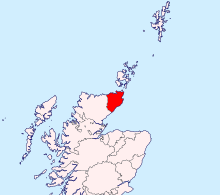| Mormaer of Caithness | |
|---|---|
 | |
| Creation date | 10th century? |
| Created by | Constantine II of Scotland? |
| Peerage | Peerage of Scotland |
| First holder | Donnchad? |
| Last holder | Maol Íosa |
| Status | Extinct |
| Extinction date | 1350 |
| Former seat(s) | Braal Castle[1] |
The Mormaer of Caithness was a vassal title mostly held by members of the Norwegian nobility based in Orkney from the Viking Age until 1350. The mormaerdom was held as fief of Scotland[2] and the title was frequently held by the Norse Earls of Orkney, who were thus a vassal of both the King of Norway and the King of Scots. There is no other example in the history of either Norway or of Scotland in which a dynasty of earls owed their allegiance to two different kings.[3]
The earliest reference to the title is however to that of a native Scots ruler, Donnchad, although the extent of the Scottish crown's influence so far north at the time, beyond the lands of the powerful Mormaers of Moray, is questionable.[4] The Norse saga which mentions Donnchad does not provide a date,[5] although the context suggests the early tenth century. Nonetheless, at least since the childhood of Thorfinn Sigurdsson in c. 1020, but possibly already several decades before, the Earls of Orkney were the controlling figures. In the Norse context the distinction between earls and kings did not become significant until the late 11th century[6] and the Caithness mormaers therefore would have had considerable independence of action until that time.

The Pentland Firth, between Caithness and Orkney, was a stretch of water which divided the two earldoms but also united them, especially perhaps for the Norse, whose command of the seas was an important aspect of their culture. Indeed there are numerous incidents recorded in the Orkneyinga saga in which movement across these waters occurs as if the two polities were parts of a single political and cultural arena.[7][a] Even in the mid-12th century it appears that a king of Norway - Eystein Haraldsson - had no difficulty in capturing Harald Maddadson, an Earl of Orkney, from his base in Thurso, Caithness. Meanwhile a Scottish king, David I, exercised control of both areas through promotion of the Scottish Church and other indirect rather than military means.[7] In the 13th century, especially after the Norwegian defeat at the Battle of Largs and the subsequent Treaty of Perth in 1266, the distinctions hardened and the Firth became more like a "state border".[9]
Sutherland was part of the Caithness mormaerdom for most of this title's history, but was "taken" by Alexander II from Magnus, the first "Angus" earl, and given to others for unknown reasons.[10]
Most dates during the Norse period are approximate, but records become more detailed and historically accurate as the line of Norse jarls comes to an end. After the close of the Jarls' Saga on the death of Jon Haraldsson in 1230, the history of Caithness is "plunged into a darkness which is illuminated by very few written sources".[11][b]
After the rule of Maol Íosa there was no mormaer of Caithness from c. 1350 to 1379.[11] The title Earl of Caithness was granted to David Stewart, a younger son of the Scots king, and the mormaerdom effectively continued as an earldom from that point onwards.
- ^ Crawford (2003), p. 326 fn 171
- ^ Crawford (2013), p. 19
- ^ Crawford (2003), p. 64
- ^ Crawford (1987), p. 64
- ^ Sturlason, Chapter 99. "History of the Earls of Orkney"
- ^ Crawford (2013), p. 165
- ^ a b Crawford (2013), p. 23
- ^ Crawford (2013), p. 30, footnote 66
- ^ Crawford (2013), pp. 24–26
- ^ Crawford (2013), pp. 280–81
- ^ a b Crawford (2013), p. 26
- ^ Woolf (2007), p. 267
- ^ Crawford (2013), pp. 39–50
- ^ Williams (2007), p. 131
Cite error: There are <ref group=lower-alpha> tags or {{efn}} templates on this page, but the references will not show without a {{reflist|group=lower-alpha}} template or {{notelist}} template (see the help page).